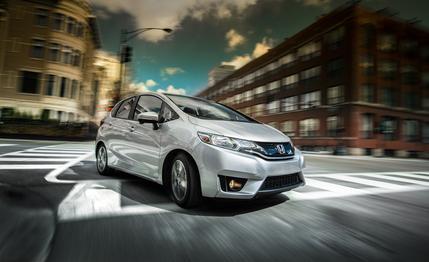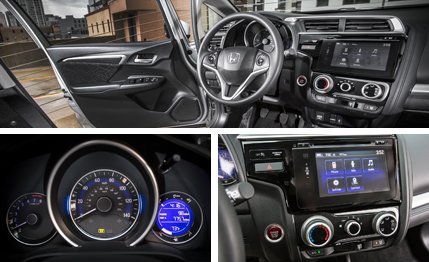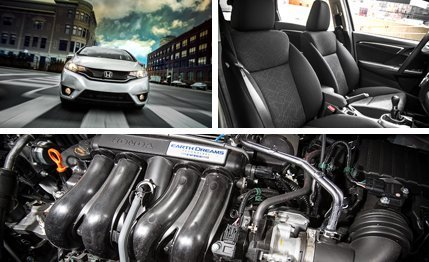 Instrumented Test
Instrumented Test
If the personal-transportation choices of Americans were based solely on need and practicality, we’d have a much narrower spectrum of vehicles on our roads. From the hundreds of models available now, we’d need just four: 50-cc mopeds for single people, bitty five-door hatchbacks for couples, minivans for larger families, and pickups for those who pack nail guns or pilot a Ditch Witch. In fact, we’re pretty sure this is how they do it in Europe.
If they ever put us in charge, the Honda Fit will be mankind’s hatchback. Since it appeared on the scene in 2006, the fun-size Honda has been our reflexive recommendation for pretty much everybody on a budget, including the old lady in the shoe. To date, this spacious, bodacious cube has pulled in seven 10Best trophies and three comparison-test wins. So its redesign for 2015 makes us nervous. Can the new Fit possibly live up to the untouchable standard set by the old?
 Dressier interior fittings justify a slightly higher price.
Dressier interior fittings justify a slightly higher price.
It sits on a new platform, it’s powered by a new engine spinning new transmissions, and it wears a new look. That last point, at least, is a definite plus. For the first time, aesthetics seem to have been a prime consideration in the Fit’s design. As with the styling of many minicars, it’s polarizing. But the past two Fits haven’t polarized anybody; they’ve looked dorky to everyone.
The 2015 Fit seems much bigger than its predecessor, but it is actually the same height, 1.6 inches shorter, and just 0.3 inch wider. The engorged appearance comes from a dramatically reduced glass-to-body ratio. The greenhouse is shorter, even if the car itself is not. This gives the Fit a more substantial appearance. And it is more substantial, although only slightly. This car’s curb weight of 2572 pounds is up 52 from the last Fit we tested. As far as cars are concerned, that’s just water weight.

In spite of the small increase in mass, the car sees big gains in rigidity. It’s still a playful chassis for an affordable stuff-shuffler. There’s little roll, and wheel and body motions are well controlled even when you smack a mid-corner bump. Without an available rear anti-roll bar like that on the outgoing Fit Sport, the 2015 model isn’t quite as neutral. But it’s fun, and certainly more so than any of the nonexistent cars that offer a Fit-sized interior at this price. The rack-mounted electric power-steering motor takes orders from a sturdier shaft; while a modicum of feel remains, it’s a bit muted and less immediate than before, and this flattens the fun on turn-in. Both the 0.79-g skidpad grip and 178-foot stopping distance are average for its B-segment cohort (Chevy Sonic, Ford Fiesta, Mazda 2). But the brakes are actuated by a pedal that is squishier than the last Fit’s, again sapping a touch of the old car’s charm.
There’s a shade less zeal underhood, too. While more powerful, the engine is missing the touch of rasp that reminded its driver of other high-profile VTEC screamers. It still displaces 1.5 liters, but that’s about it for similarities between Fit engines new and old. Now it’s stuffed with direct injection and dual overhead cams (where before there was port injection and just one lobestick). In addition to i-VTEC’s dual-profile intake cam, the 1.5 packs VTC, or Variable Timing Control, which retards intake valve timing at low rpm and advances it at high engine speeds. New oil jets cool the undersides of the pistons, and the crankshaft has been lightened 27 percent through smaller journals and a 50-percent reduction in counterweights, from eight to four. An additional 13 horsepower and 8 pound-feet of torque, for totals of 130 and 114, respectively, don’t sound like much gain for all of that effort, but this is just a 1.5. That increase in power and shorter gearing drop the zero-to-60-mph time from 8.4 seconds to 8.0. At 16.2 seconds and 86 mph in the quarter-mile, the Fit would have outrun every car in our last comparison test of this class [“Appetizers,” November 2011]. Fuel economy with the manual hits 29 mpg city and 37 highway. Shifting primarily at the 6800-rpm redline, we logged 30 mpg.